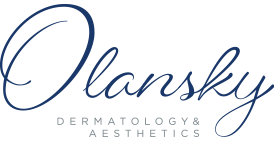Though it can be fun to channel your inner bohemian by crafting face masks and other skin treatments at home, there’s a realm of facial care that requires an expert’s touch.
At Olansky Dermatology & Aesthetics we support individual talent, expression, and success, but there are some aesthetic treatments we advise you don’t try at home.
Chemical Peels
They might have been around since Cleopatra, but chemical peels can involve more complicated laboratory science than your private kitchen or bathroom may be quite ready for. Only a trusted dermatology specialist should apply a chemical peel.
“Chemical peeling involves the application of a chemical agent of a defined strength that results in exfoliation of the skin followed by regrowth of new skin leading to skin rejuvenation,” a study in the Journal of Cutaneous and Aesthetic Surgery summarizes. “It is a technique-dependent procedure. Although rare, complications may occur including persistent erythema, milia, scarring, etc.”
Though internet advice may make you feel confident about conducting a chemical peel on your own, “It is always best to go to a skincare specialist or a cosmetologist for your chemical peel treatment and follow their skincare routine and advice about how to proceed,” the Missouri College of Cosmetology asserts. At Olansky Dermatology & Aesthetics, we wholeheartedly agree. Better living through chemistry may exist, but in this case, it’s better to leave it to the actual chemists.
Microneedling
A popular skincare regimen these days involves microneedling — puncturing the skin with miniature fine needles drawn across the skin’s surface with a special roller. These miro-punctures induce the release of collagen and other growth factors, which can amplify blood flow, improve appearance, heal acne scars, and shrink pores.
While there are several at-home “solutions” available, after a deep dive into the procedure, even Elle magazine concluded: “at-home rolling should never be done with needles exceeding 0.5 mm—the risk of infection is too high—yet . . . at that particular length, little damage is being done to the skin, and therefore little actual collagen-building is being triggered.”
What does this ultimately mean? Doing it yourself results in not doing much at all, beyond increasing the risk of scarring and infection that could make matters worse.
Injectables
Dermal fillers and Botox can be a means for smoothing out wrinkles, plumping up complexions, and decreasing signs of aging.
With such a spectrum of possibilities, it may seem hard to go wrong, but experts at Harvard Health caution that “Choosing the right type of dermal filler requires the guidance of an experienced, board-certified dermatologist or cosmetic surgeon with a thorough understanding of facial anatomy, and familiarity with the variety of available fillers and their respective injection techniques.”
Beyond ensuring that you’re getting ingredients that are FDA-approved and right for your skin, an expert will ensure the procedure is done in a way that minimizes infection and other risks including potential blindness or tissue death if the filler is injected incorrectly.
Whenever a needle is involved, we at Olansky Dermatology & Aesthetics advise that an expert is at the other end of it — to ensure your safety and the procedure’s success.
Believe it or not, there are other DIY contents and practices to avoid, but we’re here to discuss all of them with you. No matter what procedure your skin requires, our specialists will help you do it right. Schedule a consultation with us by calling (404) 355-5484 or visit us online.


